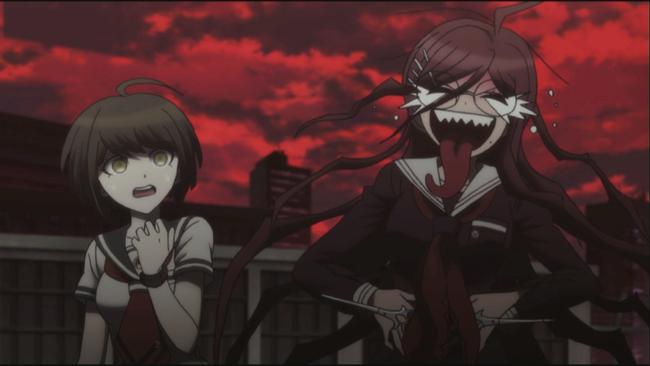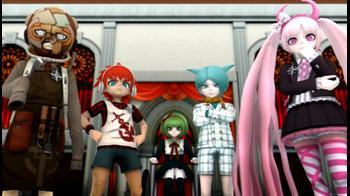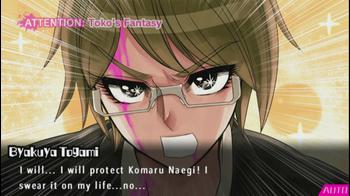
DanganRonpa Another Episode: Ultra Despair Girls Review
Spike Chunsoft's popular despair-fueled visual novel franchise returns with a spin-off. Is the shift in genre well-executed, and how does the game stack up to its predecessors?
DISCLAIMER: THIS REVIEW HAS SIGNIFICANT SPOILERS FOR THE ORIGINAL DANGANRONPA: TRIGGER HAPPY HAVOC

Ultra Despair Girls is a significant departure from the mainline titles. The contained murder mystery "killing game" has been traded in for a high-scale struggle to survive in a city under heavy attack by robots of the series' "beloved" mascot, Monokuma, and the depraved children that control them. Any implications and speculation of the state of the world is no longer valid, as the devastation is out in the open. However, the biggest change is the shift in genre from a mini-game filled court-going visual novel to a pure third-person shooter.
The setting is Towa City, one of the last bastions of civilization in the ruined world that has been overrun by a group of deranged children calling themselves the "Warriors of Hope". Joining them are the murder-hungry Monokuma Kids, helmet-wearing children that command the Monokuma robots to murder adults.
You play as the meek yet optimistic Komaru Naegi, the little sister of the first game's protagonist, Makoto. After being imprisoned in an apartment for a year with no knowledge of the grim state of the world, she manages to escape as a result of the city being overrun. Accompanying her in her attempt to flee the city is Toko Fukawa, the Ultimate Writer housing a serial killer split personality known as Genocide Jill.
The plot utilizes a very different structure from the "trapped" premise of the mainline games. The sense of progression is more akin to a city-trotting adventure as Komaru treks across Towa to escape with Byakuya and Toko. Because of this, the crazy twists and revelations fans of the series are so fond of appear with far less frequency. The ones that do occur are among the most intense and well-executed moments the franchise has seen thus far, culminating in an emotional rollercoaster of a climax.
Creative and larger than life characters have been a staple for the series since day 1, and Ultra Despair Girls is no different. The Warriors of Hope are a twisted, yet fascinating group, made all the more fascinating by the fact they're children. Komaru, despite intentionally playing the "normal" card, is pretty likable and goes through some great development as the story progresses.
Toko, who had previously been one of the least fleshed out and likable characters of the first game, is developed far beyond the comedic tropes she encompassed in her original appearance.
That being said, not everyone receives the attention they deserve. Another unfortunate trend of the series is wasted potential among secondary characters, and Another Episode keeps the tradition going with more missed opportunities.
The themes explored in Ultra Despair Girls are darker and heavier than what the series has seen previously, and neither predecessor is exactly a light-hearted walk in the park. It isn't just at select points, but nearly the entire journey.
The streets are littered with mangled corpses and the young antagonists display a surprising level of direct cruelty which only gets worse as the story progresses. When the enemies are children, there's definitely going to be some uncomfortable topics brought up that few games are willing to tackle.
Chilling written accounts of this new tragedy's victims are scattered throughout the city, fleshing out the world and accompanying the disturbing visuals to really drive home the scale of devastation that has plagued it. Many of these notes are downright depressing, even in the context of the despair-fueled DanganRonpa universe.
The dark and sometimes inappropriate humor is still present despite the raised stakes and sense of bleakness further highlighted. Thankfully, there is a generally deeper meaning to it all, which can be pretty effective and disturbing in retrospect.
The graphics are a melding of distinct, visually-appealing styles. Some of the cardboard cutout visuals of the mainline games make a return for executions and other specific cutscenes, but they have mostly been abandoned for more standard 3D models. A few of the cutscenes are fully animated by the same team that worked on the anime adaptation of the first game, a series first.
Generic adult NPCs are mostly represented by basic human shapes lacking detail, colored blue and pink for men and women respectively. This level of stylization does make the ever-growing pile of bodies less visually gruesome, but leaving it to the imagination arguably makes it more disturbing as you try to figure out how some bodies ended up in the position they did in the first place.

The combat employs standard third-person shooter gameplay. The weapon of choice is a gun shaped like a megaphone. The series iconic “truth bullets” make a return as actual bullets with numerous types. The default “break” bullet would be a standard pistol bullet, the “knockback” bullet a weaker shotgun, “burn” a sub-machine gun, and so on.
Not all bullets are directly useful as weapons, with some such as “move” and “detect” having a more environmental-related function, getting rid of obstacles and searching for hidden messages or hints respectively.
If things gets too difficult for Komaru, the player can rely on Toko to call upon Genocide Jill. By controlling the scissors-wielding serial killer, the game brings in elements from the hack n' slash genre. With Jill’s weapon, she can bulldoze through Monokumas with no trouble at all, even when ignoring the fact she can’t be killed.
She does however have a time limit, which is based on the amount of batteries the player has at any given time. The limit can be upgraded alongside other techniques via the many Monokuma Kid shops scattered throughout the city.
The combat is functional but ultimately unremarkable, and can get pretty tedious due to the length of some of the areas. Equippable skills found throughout the city can allay this somewhat, but basic functions like "aim better" should be based around the player's skill level and not a filler-prone upgrade system.
There are still moments of plot-relevant brilliance woven into the gameplay, but they are few and far between. You will find yourself looking forward to the numerous cutscenes over the actual gameplay. The team over at Spike Chunsoft seems to have anticipated this, as they threw in a mode allowing the player to use Genocide Jill indefinitely, making every enemy encounter a cakewalk.
The level design is passable for the most part. There is some backtracking, but it's generally pretty unobtrusive due to the "wrap-around" way the areas are structured .
Outside of combat, the game also features challenges and puzzles in the form of "MonokuMan Rooms". These areas generally consist of Monokuma robots arranged in a way where they can be destroyed by a specific method given by the arcade machine at the entrance to the room.
For example: a dynamite-holding "Bomber Monokuma" may need to be destroyed at the right time so that the surrounding enemies would simultaneously share its fate. As the game progresses, these rooms become more complex, requiring the player to utilize different truth bullets and think several steps ahead.
The unremarkable combat is partially alleviated by the The MonokuMan Rooms, housing some competent brain-busters. Their simplicity and general lack of difficulty do hold them back from excellence, but they are a nice distraction from all the shooting.
Overall, DanganRonpa: Another Episode is a fantastic entry in the franchise and far more worth your time than the "spin-off" status would imply. In spite of its sub-par combat mechanics, fans of the series will find plenty to love about this fascinating and intense lore-furthering side-story, from the colorful cast of dysfunctional characters to the simple yet memorable puzzles.


